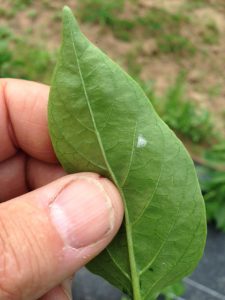Sweet Corn
IPM Program personnel are currently finishing deployment of the black light trap network in New Jersey. At present, we are approximately 80% operational and have begun to monitor traps. To date, no corn earworm (CEW) have been captured. The low numbers of European corn borer (ECB) moths that have been caught do not allow us to produce a map image. As numbers increase, look for population maps of ECB, CEW and CEW catches from pheromone traps in this weekly publication. The Vegetable IPM Program is expanding the use of CEW pheromone traps to include central and northern counties this year. The resulting full-state maps will include interpretive information.
The highest nightly trap catches of ECB for the week ending 5/08/19 are as follows:
Georgetown 1 Woodstown 1
Hillsborough 1

European corn borer egg mass on a pepper leaf.
Cole Crops
Imported cabbageworm (ICW) and diamondback moth larvae (DBM) have not yet been found in cole crop plantings in central and northern NJ. These infestations should appear and increase rapidly as the spring season progresses. Check 5 consecutive plants each in 10 random locations throughout the planting, paying particular attention to the innermost leaves where ICW often feed. Consider treating if caterpillars are found on 10% or more plants that are in the 0-9 true leaf stage. From 9-leaf to the early head stage (in broccoli, cauliflower, and cabbage) infestations up to 20% may be tolerated. Once heads begin to form, a 5% threshold should be observed to protect the marketable portion of the plant. For leafy greens such as collards and kale, 10% plants infested is the threshold throughout.
Some populations of DBM are resistant to carbamate and synthetic pyrethroid insecticides. The lack of DBM control with these insecticides has been noted in NJ previously. It is important to distinguish between common cole crop pests for this reason. DBM larvae grow to a length of approximately 0.5”, and taper toward both ends. These caterpillars thrash violently when disturbed. ICW grow to a length of approximately 1.25” and are covered with short hairs. Newer chemistries that specifically target caterpillar pests are effective against DBM as well as all other caterpillar pests of cole crops. These materials include (active ingredient – trade name (IRAC* code)):
Spinosad/Spinetoram – Entrust/ Radiant (5)
Chlorantraniliprole – Coragen (28)
Cyantraniliprole – Exirel (28)
The IRAC group 5 insecticide, Entrust, is OMRI approved for organic production. Insecticides based on the soil-inhabiting bacterium Bacilllus thuringiensis (B.t.) may also be effective on caterpillar pests of cole crops. Examples include Xentari and Javelin.
Flea beetles are very active in a number of plantings, particularly during the warmer days. These pests have a preference for the “hotter” flavored crops like arugula, mustard greens, and turnip greens. They also attack Tuscan or lacinato kale frequently. Plants may be protected with at-planting, soil-applied neo-nicotinoid insecticides (see the 2018 Commercial Vegetable Production Recommendations for products). An OMRI approved foliar material for flea beetle management is Pyganic. This product will provide knock-down of flea beetles, but may need to be applied frequently on preferred host crops.
Allium leaf miner
Captures of allium leaf miner (ALM) adults on sticky cards have declined dramatically from their high of two weeks ago, when cards captured 9-11 ALM per week. Cards from chive and garlic plantings in Mercer, Hunterdon and Warren counties have had 2 or less flies/week for the week ending 5/08/18. Damage was excessive in chives, with significantly less in garlic when the garlic plantings were not located near the chives. This first adult flight was earlier than last year and seems to be winding down about 2 weeks earlier than in 2018.

